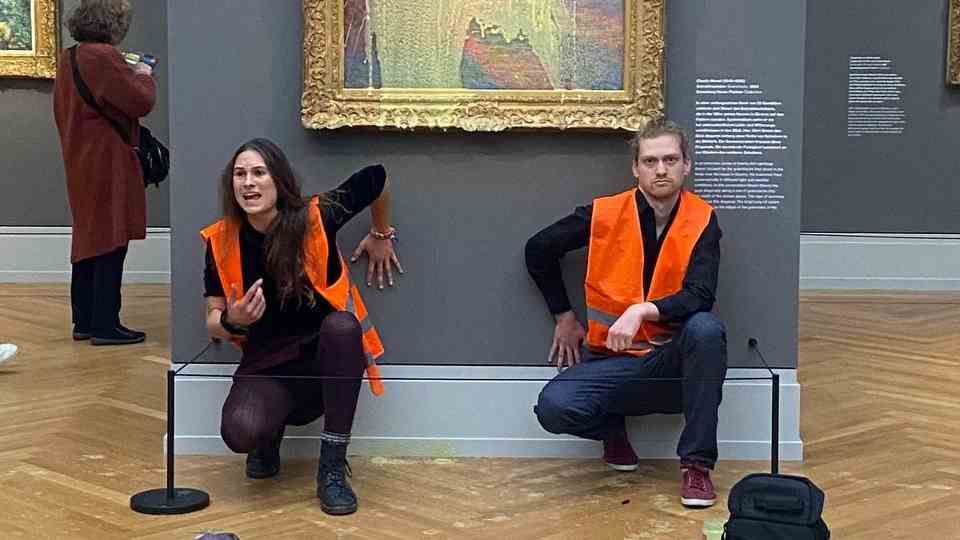Attacks by climate activists
Glazing, motion detectors, plexiglass hoods: what museums do to protect art
Visitors look at “The Great Last Judgment” by Peter Paul Rubens in the Alte Pinakothek in Munich. Several museums have recently been the target of activists
© Felix Hörhager / DPA
Activists target museums: environmentalists threw mashed potatoes at a valuable painting by Claude Monet in Potsdam. What can museums do to better protect their works of art?
After the attack by climate activists on a painting by Claude Monet, the outrage is great – but also the fear of further attacks on valuable cultural assets. Many museums have already increased their precautions, said the managing director of the German Museum Association, David Vuillaume, of the German Press Agency in Potsdam. He doesn’t see the solution as simply hiring more security guards. In such incidents, the stress level of the employees is very high. “We have to prepare the employees for this and also accompany them psychologically,” said Vuillaume.
First measure in the Potsdam Museum Barberini, where the painting “Getreideschober” (1890) was poured with mashed potatoes on Sunday: the museum will remain closed for a few days. “During this time we will consider how we can increase security,” said museum founder and art patron Hasso Plattner to the “Potsdamer Latest News”. But it is not only in Potsdam that people are currently thinking about how to protect the valuable art treasures from such attacks in the future, other large houses are also discussing this. Is the security concept still up to date?
Museums exchange information about the protection of art
The fact is: “The attack on a work from the Hasso Plattner Collection as well as previous attacks on works of art, including in the National Gallery in London, have shown that the high international security standards for protecting works of art in the event of activist attacks are not sufficient and need to be adjusted “said Barberini director Ortrud Westheider about the closure of the house announced until October 30th. The climate protest group “Last Generation” claimed responsibility for the attack. She calls for more decisive action against climate change.
What does security look like in practice? Will emergency kits with protective blankets and adhesive removers soon be part of a supervisor’s equipment? “We have made our staff aware of possible scenarios. For security reasons, we do not want to disclose our specific precautions,” said a spokeswoman for the Lenbachhaus art museum in Munich, which is known for its Blue Rider art.
“Large bags are already not allowed in the museum. We are thinking about how we can be even more attentive, especially with regard to what things visitors are taking with them,” says Stefan Weppelmann, head of the Museum of Fine Arts in Leipzig. Museums in North Rhine-Westphalia want to check visitors more closely at the entrance. A spokeswoman for the Kunstsammlungen NRW said: “We have exchanged views with other museums and affected colleagues and developed an emergency plan.”
In the Frankfurt Städel, the security standards correspond to the “highest international standards,” said the art museum. At the end of August, two climate activists glued themselves, each with one hand, to the frame of a large painting. The picture “Thunderstorm with Pyramus and Thisbe” by Nicolas Poussin is now symbolic of the destructive course of current politics, the group “Last Generation” had explained.
The attacks on the Barberini Museum in Potsdam and the Frankfurt Städel are not the only attacks on valuable art. In mid-October, climate activists threw tomato soup at Vincent van Gogh’s 1888 “Sunflowers” in London’s National Gallery. The painting was protected with glass, only the frame was damaged. In August it hit the Berlin Picture Gallery and a picture by Lucas Cranach the Elder (1472-1553). Two activists glued themselves to the frame. Similar actions also took place in Glasgow and Manchester at the beginning of July.
The attacks in Glasgow and Manchester were the reason for the Staatliche Kunstsammlungen Dresden (SKD) to implement protective measures for the works of art: “The works are protected from attacks by various structural, technical and organizational measures,” the SKD told the Deutsche Presse- agency with.
“I don’t want museums to become high-security zones”
What can museums really do to protect art? The Sprengel Museum in Hanover “briefed” caretakers, security guards and the restorer, said spokeswoman Judith Hartstang. Attacks on works of art are a criminal offense and would be punished with a criminal complaint. “The plants that were last affected in London and Potsdam were behind glass – probably the best protection against paint, soup or mashed potatoes attacks,” she explained. In addition to glazing, the Sprengel Museum has acoustic motion detectors, plexiglass hoods for bases and spacers.

However, museums also point out that they want to remain as a place without barriers as far as possible. “I don’t want museums to become high-security zones,” said Hermann Parzinger, President of the Prussian Cultural Heritage Foundation (SPK), the “Welt”. “We can’t put a security guard next to every picture, every sculpture.” Museums should be open, social and welcoming places for all people, and this trust should not be abused.
A concrete danger sees about the longtime editor-in-chief of the star, Henri Nannen, donated art gallery in Emden in Lower Saxony. So far, the activists have primarily chosen large houses with works by old masters for their attacks, said spokeswoman Ilka Erdwiens. She condemned the incident in Potsdam: “Art of all things, which is supposed to serve to open one’s own perspective, one’s view and to expand one’s consciousness.” These are ideals that the climate protection movement itself is demanding.
The Director General of the Bavarian State Painting Collections, Bernhard Maaz, said: “We expect activists not only to demand respect for nature, but also to have respect for culture.” Minister of State for Culture Claudia Roth (Greens) made a similar statement in “Focus”. “Attacking art for climate protection – in my view, that is definitely the wrong way.”




